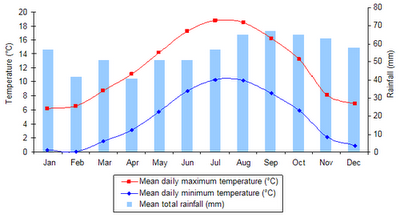HOW MUCH CAN YOU COLLECT?
To work out how much you can collect, you have to think about how often it rains and how much rain arrives. I live in Manchester, UK, where it's fair to say it rains every 3 days, or we have that kind of reputation anyway! If you live somewhere hot and dry you may have problems with infrequent rain, which, when it does arrive there is so much you hate it and then, all of a sudden, it's gone again and you are back to hot and dry weather. Anyway, you know about where you live so you know best. However, you can look up the rainfall from a local weather station which will give rainfall typically data is millimetres of rain, collected monthly. Now millimetres means just that, the depth of the rainfall, rain falls every where equally so if you have a small cup or a large bucket, you will collect the same number of millimetres, depth of water. The volume of water you collect depends on the AREA of the cup, or the bucket, or the pond or the roof etc. etc. Normally, you can easily get your hands on mean i.e. typical monthly rainfall in millimetres. Try websites like WUNDERGROUND for this. The following graph is for Edinburgh, Scotland -which like Manchester, England, gets frequent rainfall throughout the year. (Click and zoom for a closer look...)

HOW BIG IS YOUR ROOF?
The best way to collect rainwater from a large area is to use the roof of your house. It doesn't matter whether it's a pitched roof with an apex or a flat roof, the pitched roof will not collect anymore water than the flat roof, providing you have a gutter or drainage channel to retrieve the water, and your roof is relatively clean, then, you're in business. If you know the width and length of the roof in metres you can work out how much water you can collect in a month, in the following way:
mm rainfall divided by 1000
x width (metres) x length (metres)
and divide the total by 1000, this is how many litres of water you can collect in a month.
Water Demand = number of litres a month you will use up.
Providing rainwater is filtered, it can be used for laundry. Laundry - 65 litres per load is a good guess for a front loading European style machine.
Rainwater can be used to flush the toilet, this requires some plumbing work to pump the water to the cistern -it will not fill if the supply has no pressure. Water use for toilet flushing -a good guess is 5 flushes per person per day living at home. What type of cistern have you got? 6 litres, 9 litres, 13 litres? see this POST for help
Calculate: cistern size (litres) x no.of people x 5 flushes per day.
Gardening - this could be anything, depends on your passion for gardening!
Add up all you figures for demand from gardening/laundry/toilets.
Compare your demand figure to your litres of rainfall. Ideally you want these figures to be equal, to collect as much as you want to use. If the rainfall is higher then this is not a problem, but if the demand is more then you could try increasing the size of the tank, or looking for another roof to take water from, or reduce your demand somehow. Also remember that water demand for gardening will be seasonal.
To get the right size tank you have to consider another factor -frequency of rainfall, this just goes on your judgement and any detailed rainfall data you can get your hands on of course! In the UK, as it rains so frequently, a 14 day storage is advisable, so that if an enormous deluge of rain occurred and then it was dry for the next 2 weeks you would be able to "ride the wave" between supply and demand. How do you check this -calculate:
14 x daily demand for gardening/laundry/toilet flushing = tank size
Now if you live in Australia, for example, you may find a much, much larger store (storage for 8 weeks or more) is necessary to make your project worthwhile.
VH87G87C7HS6

